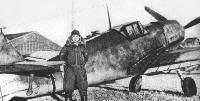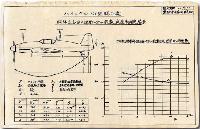Фотографии
-
Three Messerschmitt Bf 109E-7s were imported into Japan and tested extensively by both the IJAAF and the IJNAF. One of the Navy test pilots stated that he found the Bf 109’s cockpit narrow and cramped, although its acceleration in a dive was exceptional. Unsurprisingly, of the German fighters tested by Japan, the Fw 190 was deemed the best.
Самолёты на фотографии: Messerschmitt Bf.109E - Германия - 1938
-
The sole Focke-Wulf Fw 190A-5 imported into Japan arrived in the late summer of 1943 and was tested against Japanese fighters at Fusa airfield, near Tokyo. It was highly rated by test pilots, but was not selected for production in Japan
Самолёты на фотографии: Focke-Wulf FW.190A - Германия - 1941
-
An original Japanese technical document, dated September 1, 1942, detailing the results of a series of airframe vibration tests of one of the three Heinkel He 100D-0 sentoki (fighter) aircraft delivered to Japan in May 1940. The blisteringly fast Daimler-Benz DB 601-powered He 100 became the inspiration for Japan’s Kawasaki Ki-61 Hien fighter.
Самолёты на фотографии: Heinkel He-100 - Германия - 1938
-
Based on the DB 601 that powered a number of Germany’s wartime aircraft, the 1,100 h.p. Kawasaki Ha-40 12-cylinder liquid-cooled supercharged direct-fuel-injection engine was used to power the IJAAF’s Ki-61 Tony fighter. Liquid-cooled engines were not favoured in Japan, the vast majority of its fighting aircraft being fitted with more rugged radial engines.
Самолёты на фотографии: Kawasaki Ki.61 Hien - Япония - 1941
-
Clearly showing its German heritage, the Kawasaki Ki-61 Hien (Allied reporting name Tony), powered by the same company’s Ha-40, essentially a licence-built DB 601, was the only inline-engined Japanese fighter to see extensive operational service during the Second World War.
Самолёты на фотографии: Kawasaki Ki.61 Hien - Япония - 1941
-
Three Messerschmitt Me 210A bomber-destroyers were supplied to Japan for evaluation. This example, WNr 2350, was brought up to Me 410 standard while still retaining the 210’s original DB 601 engines, which were replaced on the 410 with more powerful DB 603s.
Самолёты на фотографии: Messerschmitt Me.210 - Германия - 1939
-
One of Germany’s most dramatic and potentially significant wartime developments was the Messerschmitt Me 163 rocket-powered interceptor, which the Japanese understood could be of immense value against the waves of USAAF B-29 bombers pummelling Japan from mid-1944.
Самолёты на фотографии: Messerschmitt Me.163 Komet - Германия - 1941
-
The original plan had been for Japan to manufacture both the Messerschmitt Me 262 and Me 163B and their powerplants under licence - but, when the bulk of blueprints and technical details sent by submarine from Germany were lost at sea, the Japanese were forced to come up with their own design, the Mitsubishi J8M/Ki-200.
Самолёты на фотографии: Mitsubishi J8M Shusui - Япония - 1945
-
The Japanese Toku-Ro 2 bipropellant rocket engine, based on the German HWK 509A, was capable of some 3,300lb (1,500kg)-thrust, but was too late to have an impact on Japan’s war effort.
Самолёты на фотографии: Mitsubishi J8M Shusui - Япония - 1945
-
The MXY8 was a training glider version of the rocket-powered J8M. The prototype J8M1 crashed on its first flight on July 7, 1945.
Самолёты на фотографии: Mitsubishi J8M Shusui - Япония - 1945
-
Also based on a German design - the BMW 003A - the Ishikawajima Ne-20 was Japan’s first turbojet powerplant, and was intended to power the twin-engined Nakajima Kikka and later variants of the Yokosuka MXY7 Ohka (Cherry Blossom) suicide aircraft.
Самолёты на фотографии: Nakajima J8N Kikka - Япония - 1945
-
Although broadly similar in configuration, the Nakajima Kikka had none of the aerodynamic finesse of its inspiration, the larger Messerschmitt Me 262. Completed in August 1945, the prototype made its maiden flight on August 7; one more flight was attempted (but aborted on take-off) before Japan's surrender on August 15.
Самолёты на фотографии: Nakajima J8N Kikka - Япония - 1945
-
В 1930 году прототип KDA-5 показал скорость 322 км/ч, что ставило его в один ряд с такими истребителями, как Hawker Fury и P-12.
An example of the German influence on Japan’s pre-war fighter aircraft, the Kawasaki KDA-5 (Army Type 92 Fighter in IJAAF service) was designed by German expat Richard Vogt in 1930. The single-seat biplane fighter made its maiden flight the same year and in tests set a new Japanese speed record of 173kt (200 m.p.h./320km/h).
One of the fastest single-seat fighters in the world at the time of its appearance in the early 1930s, the Kawasaki Army Type 92 could attain 200 m.p.h. on the power of its 500 h.p. Kawasaki-BMW VI water-cooled 12-cylinder vee engine. Despite this, it was not liked by pilots or groundcrew, having poor takeoff and landing characteristics and proving difficult to maintain.Самолёты на фотографии: Kawasaki KDA-5 / Type 92 - Япония - 1932
-
Impressed by the unusually configured Heinkel He 119’s high speed and long range, the Japanese sent a team of nine technicians from the Naval Air Technical Arsenal at Yokosuka to the Heinkel factory at Marienehe to study the aircraft. Two examples were sent to Japan in May 1940 for testing.
Самолёты на фотографии: Heinkel He-119 - Германия - 1937
-
One of the types demonstrated to the Japanese delegation at Rechlin in June 1944 was the turbojet-powered Arado Ar 234B, two prototypes of which were put into service as highspeed reconnaissance machines that July.
Самолёты на фотографии: Arado Ar.234 Blitz - Германия - 1943
Статьи
- -
- D.Gordon - Spies in Cold War Skies
- G.Alegi - Macchi's Sky Scooter
- J.Franzi - To Hell and Back... /An eye for detail/
- J.Stroud - An Englishman in New York /The John Stroud Archive/
- K.Hayward - Trident. Britain's Fork in the Road?
- K.Honey - In the Land of Black Gold
- N.Mathisrud - The Other Stockholm Run
- N.Stroud - Willard Custer & the Channel Wing
- P.Davidson - Off the Beaten Track...
- P.Jarrett - Lost & Found
- R.Paver - Black on Wight
- T.Cooper - ...Blaaaam! Six dramatic minutes over Angola
- T.Oliver - Hands Across the Water?
- W.Robinson - The Reluctant Overnight Hero














